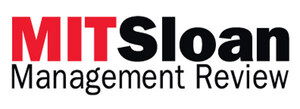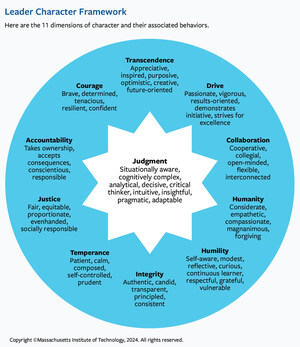CAMBRIDGE, Mass., Feb. 16, 2022 /PRNewswire/ -- According to new research released today in MIT Sloan Management Review, employees with high measures of well-being upon starting a job deliver superior performance at a dramatically higher rate than those with lower measures of happiness.
Paul Lester, associate professor of management at the Naval Postgraduate School, Martin Seligman, director of the University of Pennsylvania's Positive Psychology Center, and Ed Diener, influential American psychologist, followed nearly 1 million U.S. Department of Defense employees (the single largest employer in the world) for five years, measuring their relative happiness and optimism using 25 questions drawn from PANAS and the Life Orientation Test. The participants spanned across all job functions (infantry soldiers, office workers, pilots, engineers, truck drivers, medical professionals, logistics experts, etc.).
"While we expected that well-being and optimism would matter to performance, we were taken aback by just how much they mattered," said Lester, "In short, not only do happiness and optimism matter to employee performance, but they matter a lot, and both predict how employees will do."
Within the workplace, we know that employees with higher formal measures of well-being are more likely to emerge as leaders, earn higher scores on performance evaluations, and tend to be better teammates.[i] We also know, based on substantial research, that happier employees are healthier, have lower rates of absenteeism, are highly motivated to succeed, are more creative, have better relationships with peers, and are less likely to leave a company.[ii]
The results of the research underscore the importance of employee happiness to business results and beg the question: "What can leaders do about employee happiness?"
Following the science and taking a structured approach to hiring for, promoting, and developing employee happiness, the authors urge leaders to commit to three actions:
- Measure happiness in both employees and job candidates. "We advocate using measures of happiness and optimism as discriminators, or 'tiebreakers' in the hiring process as the risks are low and benefits can be very important," noted Lester.
- Develop happiness in the workplace. Training initiatives targeting employee well-being do not require a significant time investment, are cost effective, and carry a high ROI. (Examples are included in the article.)
- Retain employees who are happy. "While organizations should want happy employees because they perform significantly better than those who are unhappy; organizations also need happy employees because happiness is in fact contagious," said Seligman.
This research with the Department of Defense over the last decade consistently uncovered a foundational truth: Employee well-being initiatives work best when confident leaders present the material and when senior leaders place significant emphasis on the overall effort.[iii]
Thus, leaders must be willing to invest their efforts into making the initiatives successful by not only advocating for them — for example, by securing resources for a program and promoting positive strategic messaging — but also by participating in the training and incorporating it into their own behaviors.
If leaders want to improve employee happiness, then they must model that which is taught so that it becomes integral to the organization's lexicon and culture.
The Research
- The researchers followed nearly 1 million U.S. Army service members for five years, measuring their relative happiness and optimism using 25 questions drawn from PANAS and the Life Orientation Test. The questions were included on a larger survey taken by every Army soldier each year.
- This well-being measurement combines individuals' own self-assessments and their reporting on the frequency of positive and negative emotions experienced, to yield the researchers' measure of happiness.
- Even after the researchers controlled for previous performance and a range of demographic factors, soldiers who were the happiest and most optimistic went on to earn significantly more job performance awards across the next five years compared with those who were initially unhappy and pessimistic.
The MIT Sloan Management Review (MIT SMR) article, "Top Performers Have a Superpower: Happiness" publishes 8 a.m. EST on Feb. 16, 2022.
About the Authors
Paul B. Lester is an associate professor of management at the Naval Postgraduate School. Martin Seligman is the Zellerbach Family Professor of Psychology at the University of Pennsylvania, director of the university's Positive Psychology Center, and a former president of the American Psychological Association. He was named by Academic Influence as the world's most influential psychologist. Ed Diener died in April 2021. He was a professor of psychology at the University of Utah and the University of Virginia, the Joseph R. Smiley Distinguished Professor Emeritus at the University of Illinois, and a senior scientist for the Gallup Organization. He received the American Psychological Association's Award for Distinguished Scientific Contributions in 2012, and his work has been cited more than 250,000 times.
About MIT Sloan Management Review
MIT Sloan Management Review (MIT SMR) is an independent, research-based magazine and digital platform for business leaders, published at the MIT Sloan School of Management. MIT SMR explores how leadership and management are transforming in a disruptive world. We help thoughtful leaders capture the exciting opportunities — and face down the challenges — created as technological, societal, and environmental forces reshape how organizations operate, compete, and create value.
Connect with MIT Sloan Management Review, on:
Media Contact:
Tess Woods
[email protected]
617-942-0336
SOURCE MIT Sloan Management Review

WANT YOUR COMPANY'S NEWS FEATURED ON PRNEWSWIRE.COM?
Newsrooms &
Influencers
Digital Media
Outlets
Journalists
Opted In






Share this article